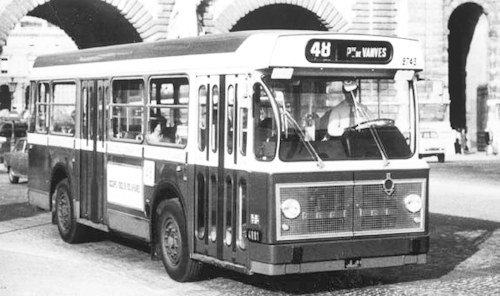Berliet PCM Bus
 | |
Make | Berliet |
Years of production | 1965 to 1971 |
Class | Bus |
Energy | diesel |
Motor (s) | L6 Berliet - MAN DO636HM8U 6 cyl Flatbed Diesel (PCMR and RE) |
Engine position | Longitudinal right forward |
Displacement | 7034 (MAN) cc |
Maximum power | 135 (150) DIN ch (99 kW) |
Transmission | Propulsion - Pont-à-Mousson Bidisque Dry Centrifugal Coupler (Wilson License) for PCMR |
Gearbox | Manual or automatic R107 |
Unloaded weight | 8120 (PCMR) 9800 (PCMRE) kg |
Maximum speed | 60 km / h |
Bodywork (s) | 2 door bus - Aluminium - Configuration 442 (2 agents) - 444 (1 or 2 agents) - 044 - 144 - 424 (PCMRE) - 422 (proto PCMRE) |
Frame | Separate chassis |
suspensions | Pneumatic - Telescopic shock absorbers - Rear stabilizer bar |
Length | 11000 (PCM) 9825 (PCMRE) mm |
Width | 2500 mm |
Height | 2970 (PCM) 4350 (PCMRE) mm |
wheelbase | 5580 (PCMR) 4560 (PCMRE) mm |
The Berliet PCM is a bus manufactured by the French brand Berliet from 1965 to 1971.
History
The Berliet PCM is a bus Berliet manufacturer to the specifications defined in 1958 by the RATP and the UTPUR (Union of Urban and Rural Public Transport) for a "standard bus “with a length of 11 m a flat floor at 63 .5 cm from the ground at most, an interior height of 2.20 m minimum with high windows 1.78 m from the floor, an anti-reflective windscreen and a 150 hp engine lying under the driving position.
The French manufacturers Berliet and SAVIEM and Verney presented a prototype on March 23, 1962, the SAVIEM SC 10, the Berliet PCM and the Verney AUS. This last manufacturer, not having the industrial capacity to ensure the planned production, withdrew almost immediately.
The lines of the PCM are very angular. The design is signed by designer-stylist Philippe Charbonneaux. Berliet is betting on an aluminium body bolted to a low-slung chassis with side members.
Equipped with the same MAN engine limited to 135 hp as the first SAVIEM SC 10.U, the Berliet PCM is more expensive to purchase because its aluminium body is bolted to a steel frame. This constructive choice makes the vehicle lighter and therefore more manageable than its competitor and its suspension is fully pneumatic with level correction, offering very good comfort.
However, corrosion sets in very quickly at the contact points between the steel of the chassis and the aluminium of the PCM body and the maintenance costs are very high. Berliet interrupts, as soon as December 1971, the production of the bus best suited to urban service that it has ever had in its catalogue to replace it with the PR 100, very noisy in its first versions and not designed for heavy load lines operated in self-service due to the absence of a rear door.
The Berliet PCMR-E is a double-decker city bus like you see everywhere in London. In the mid-1960s, the RATP launched a call for tenders for a double-decker bus in order to reduce the surface area occupied by buses while increasing transport capacity, the RATP decided to carry out an experiment by taking the example on London's double-decker buses.
Berliet responded to demand by producing, in 1966, a prototype based on the PCM in its shortened version with a second level: the PCMR-E. Presented at the RATP, this prototype received criticism because the ceiling height was too low for users. But the volume of the future market is too low for a manufacturer to launch a study for a brand-new model. The RATP ordered 25 units of the Berliet PCMR-E which entered service in 1967.
Although it received a warm welcome because passengers are attracted by curiosity, the RATP quickly noticed that users no longer went upstairs: those who take the bus for medium distances prefer to stay downstairs and save money. thus, to climb the steps and especially the ceilings are low: 1.89 meters at the bottom and only 1.70 meters at the top. 26 units built in 1968 for the RATP who reformed them in 1977 after transformation for a single agent use in 1972. They were used on lines 94 and 53. Fleet No. 2200 (prototype) at 2225.
The RATP will use for a short decade the Berliet PCMR-E which did not convince. The 26 examples built in 1968 will be reformed in February 1977.
The PCM-R 750 RATP copies. Park number: 4151 to 4500 - 4601 to 5000. (Prototype 4451)
PCM-UC It was at the request of the Marseilles network that Berliet adapted, in 1966, the body of the PH on a PCM chassis, thus giving the PCM-UC version. This strange and heterogeneous vehicle was heavily penalized by its very heavy steel body, whereas the PCM had an aluminium body. Only 16 copies will be produced.
PGR, the little PCM In the early 1960s, traffic in Paris became very difficult. Reserved lanes are not yet envisaged and the idea of seeing only 11 m buses replacing the old ones which measured 9.15 or 9.75 m frightens the Prefecture of Police, which imagines them blocking traffic at crossroads. The RATP ends up admitting the relevance of a less cumbersome bus than the SC10 and PCM. The Berliet PCMRE bus, 9.83 m long, double-decker, goes in this direction.
Berliet imagined removing the PCMRE stage and then offered a reduced version of the PCM, but without the MAN engine lying under the driver. Paul Berliet wants to avoid getting supplies from his rival SAVIEM, now the exclusive importer of MAN engines. The engine is therefore a vertical 4-cylinder Berliet positioned at the front, the M420.30 of 5.88 l (120 × 130 mm), developing 120 hp. The gearbox is a four-speed Wilson semi-automatic in the middle of the chassis. The rear axle is also an adaptation of the lowered one of the PCM. The mixed suspension comprises traditional steel blades as well as four air bags at the rear and two at the front (“Airlam” concept).
The body, in aluminium, is of a design close to that of the PCM with the famous cylindrical domed windscreen. It is 9.00 m long overall and 2.25 m wide, with the same large doors as the standard version. The floor is 65 cm from the ground. The vehicle takes the name of PGR, the "P" being the prefix of all Berliet coaches and buses, "GR" for "Reduced size".
With the exception of its engine, the vehicle retains all the characteristics of the standard and the project excites the RATP, especially since Berliet arrived (on 5/8/1966) at a very tight price of 122,478 F excluding tax on the basis of 100 units produced, when a PCM is worth 243,000, an SC10 235,000 and a PCMRE 247,300.
The first prototype was commissioned in Paris from November 28, 1968 to January 9, 1969. The RATP then orders a first tranche of 100 copies, then another of 460, to benefit from a price reduction on the totality. They are all fitted out for one agent with 45 places, including 28 seated and 17 standing.
The PGRs will cost Berliet dearly, not just because of an undervalued price but because the RATP has set high late penalties. While 76 PGR were to be delivered at the end May 1970, only 61 have been. In addition to this production delay, there are penalties for immobilization on breakdown. The addition, at the end of May 70, already amounted to 400,000 F (61,000 €). The breakdowns relate to the breakage of the legs of the seats, the compressor supports, the engine supports. The 4-cylinder Berliet engine is not only noisy but it vibrates the body which, poorly studied, amplifies the stresses. Added to this is a faulty idle. The engine is well suited for GAK and Stradair trucks that go on the road, much less on a bus that just starts and stops. The PGR breaks the record for the number of breakdowns per 10,000 km, 1.583 against 0.663 for the Saviem SC10and 0.989 for PCM. Some defects will be corrected in after-sales service and on new vehicles from the 64th unit manufactured.
With the introduction of the orange card in 1975, Parisians regained a taste for the bus. The unreliable PGR has also become too small and leaves its place, without regret, to the new 2nd generation SC10s. The last PGRs were reformed in 1983. In total, Berliet produced 606 examples of the PGR.




